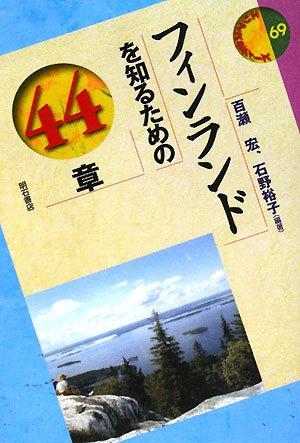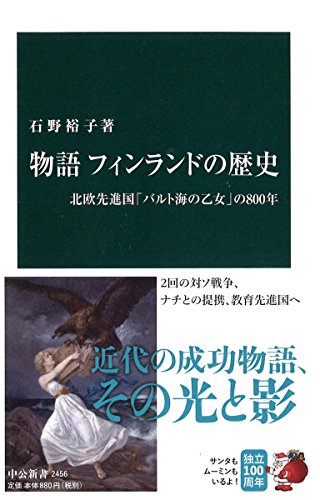4 0 0 0 IR フィンランドにおける内戦認識の変遷
- 著者
- 石野 裕子
- 出版者
- 京都大学地域研究統合情報センター
- 雑誌
- 地域研究 (ISSN:13495038)
- 巻号頁・発行日
- vol.12, no.1, pp.210-233, 2012
特集2: ヨーロッパ統合と国民国家の歴史認識
- 著者
- 石野 裕子
- 出版者
- 京都大学地域研究統合情報センター ; 2004-
- 雑誌
- 地域研究 (ISSN:13495038)
- 巻号頁・発行日
- vol.16, no.1, pp.173-195, 2015-11
3 0 0 0 OA 「大フィンランド」思想の変遷
- 著者
- 石野 裕子
- 出版者
- JAPAN ASSOCIATION OF INTERNATIONAL RELATIONS
- 雑誌
- 国際政治 (ISSN:04542215)
- 巻号頁・発行日
- vol.2011, no.165, pp.165_156-170, 2011-07-25 (Released:2013-08-05)
- 参考文献数
- 59
The purpose of this paper is to analyze the ideological background in the transition of “Greater Finland (Suur-Suomi)” idea by examining the interpretations of Finnish national epic, the Kalevala, focusing on three researchers: Kaarle Krohn, Jalmari Jaakkola and Martti Haavio.Today “Greater Finland” idea is often regarded as “expansionism”, but at first it was a sentiment only by Finnish intellectuals on Finnish “relative tribes”, mainly Karelians living in Russian Karelia adjacent to Finnish eastern border. This sentiment of Finnish “relative tribes”, however, was intended to unite Finnish and Karelians under Russian Empire rule. It was spread around Finnish people through diffusion of the Kalevala by a compiler Elias Lönrrot who gathered oral songs mainly from Karelians in Russian Karelia at the end of 19th century. This developed the theory that Karelians had kept Finnish national epic since ancient times.“Greater Finland” idea had been politicized when Russian Empire shifted policy from appeasement to deprivation of Finnish autonomy, called Russification policy at the end of 19th century. Resistance group, Aktivisti recognized Russian Karelia as a defense area against Russia, and also regarded it as a target of Finnish irredenta. This idea overlapped with independence of Finland after the outbreak of the First World War, which triggered the military action for gaining Russian Karelia just after Finish independence. Meanwhile, before and after the independence of Finland, Finnish folklorist Krohn claimed that Finland had culturally connected to Russian Karelia and Estonia in his studies.On the contrary, Finnish historian Jaakkola, who flourished between World Wars, denied the cultural relations between Finland and Estonia, and stressed the unity of Russian Karelia and Finland in ancient times instead. He also tried to place Finland as the European outpost against the attack of “barbarian Russia”. According to Jaakkola's opinion, heroes in the Kalevala were real people who expedited from Western Finland to Russian Karelia, and settled there. This interpretation had been a popular theory of Karelian origin until advocate of new theory in 1950's : Karelians and Finnish were different origins. His theory was made use of the military negotiation with Germany just before the outbreak of the second Soviet-Finnish War (19411944). Finnish government utilized Jaakkola's study for the justification of Russian Karelia's annexation.After the Second World War, Haavio claimed that Finland had come under the cultural influence of all over the world including Russia, and had had the cultural connection with Russia. Therefore the Kalevala had the nature of international epic. Now his Kalevala study was widely accepted among Finnish society which tried to build a new relationship with Soviet Union for promoting the area cooperation with Russian Karelia.It should be concluded, from what has been said above, that the concept of “Greater Finland” idea was changed from “Unity” to “Separation”, and furthermore to “Cooperation” in the transition of time.
- 著者
- 石野 裕子 イシノ ユウコ Yuko Ishino
- 雑誌
- 史苑
- 巻号頁・発行日
- vol.74, no.2, pp.51-66, 2014-03
- 著者
- 石野 裕子
- 出版者
- JAPAN ASSOCIATION OF INTERNATIONAL RELATIONS
- 雑誌
- 国際政治 (ISSN:04542215)
- 巻号頁・発行日
- vol.2011, no.165, pp.165_156-170, 2011
The purpose of this paper is to analyze the ideological background in the transition of "Greater Finland (Suur-Suomi)" idea by examining the interpretations of Finnish national epic, the <i>Kalevala</i>, focusing on three researchers: Kaarle Krohn, Jalmari Jaakkola and Martti Haavio.<br>Today "Greater Finland" idea is often regarded as "expansionism", but at first it was a sentiment only by Finnish intellectuals on Finnish "relative tribes", mainly Karelians living in Russian Karelia adjacent to Finnish eastern border. This sentiment of Finnish "relative tribes", however, was intended to unite Finnish and Karelians under Russian Empire rule. It was spread around Finnish people through diffusion of the <i>Kalevala</i> by a compiler Elias Lönrrot who gathered oral songs mainly from Karelians in Russian Karelia at the end of 19th century. This developed the theory that Karelians had kept Finnish national epic since ancient times.<br>"Greater Finland" idea had been politicized when Russian Empire shifted policy from appeasement to deprivation of Finnish autonomy, called <i>Russification policy</i> at the end of 19th century. Resistance group, Aktivisti recognized Russian Karelia as a defense area against Russia, and also regarded it as a target of Finnish <i>irredenta</i>. This idea overlapped with independence of Finland after the outbreak of the First World War, which triggered the military action for gaining Russian Karelia just after Finish independence. Meanwhile, before and after the independence of Finland, Finnish folklorist Krohn claimed that Finland had culturally connected to Russian Karelia and Estonia in his studies.<br>On the contrary, Finnish historian Jaakkola, who flourished between World Wars, denied the cultural relations between Finland and Estonia, and stressed the unity of Russian Karelia and Finland in ancient times instead. He also tried to place Finland as the European outpost against the attack of "barbarian Russia". According to Jaakkola's opinion, heroes in the <i>Kalevala</i> were real people who expedited from Western Finland to Russian Karelia, and settled there. This interpretation had been a popular theory of Karelian origin until advocate of new theory in 1950's : Karelians and Finnish were different origins. His theory was made use of the military negotiation with Germany just before the outbreak of the second Soviet-Finnish War (19411944). Finnish government utilized Jaakkola's study for the justification of Russian Karelia's annexation.<br>After the Second World War, Haavio claimed that Finland had come under the cultural influence of all over the world including Russia, and had had the cultural connection with Russia. Therefore the <i>Kalevala</i> had the nature of international epic. Now his <i>Kalevala</i> study was widely accepted among Finnish society which tried to build a new relationship with Soviet Union for promoting the area cooperation with Russian Karelia.<br>It should be concluded, from what has been said above, that the concept of "Greater Finland" idea was changed from "Unity" to "Separation", and furthermore to "Cooperation" in the transition of time.
- 著者
- 石野 裕子 イシノ ユウコ Yuko Ishino
- 出版者
- 立教大学史学会
- 雑誌
- 史苑 (ISSN:03869318)
- 巻号頁・発行日
- vol.74, no.2, pp.51-66, 2014-03
1 0 0 0 OA 「大フィンランドは祖国と同様である」 --エルモ・カイラとカレリア学徒会の地域構想
- 著者
- 石野 裕子
- 出版者
- 京都大学地域研究統合情報センター
- 雑誌
- 地域研究 (ISSN:24337358)
- 巻号頁・発行日
- vol.16, no.1, pp.173-195, 2015-11-30
第II部: 両大戦間期の中央ヨーロッパ
1 0 0 0 フィンランドを知るための44章
- 著者
- 百瀬宏 石野裕子編著
- 出版者
- 明石書店
- 巻号頁・発行日
- 2008
- 著者
- 石野裕子 [著]
- 出版者
- 津田塾大学国際関係研究所
- 巻号頁・発行日
- 2010

